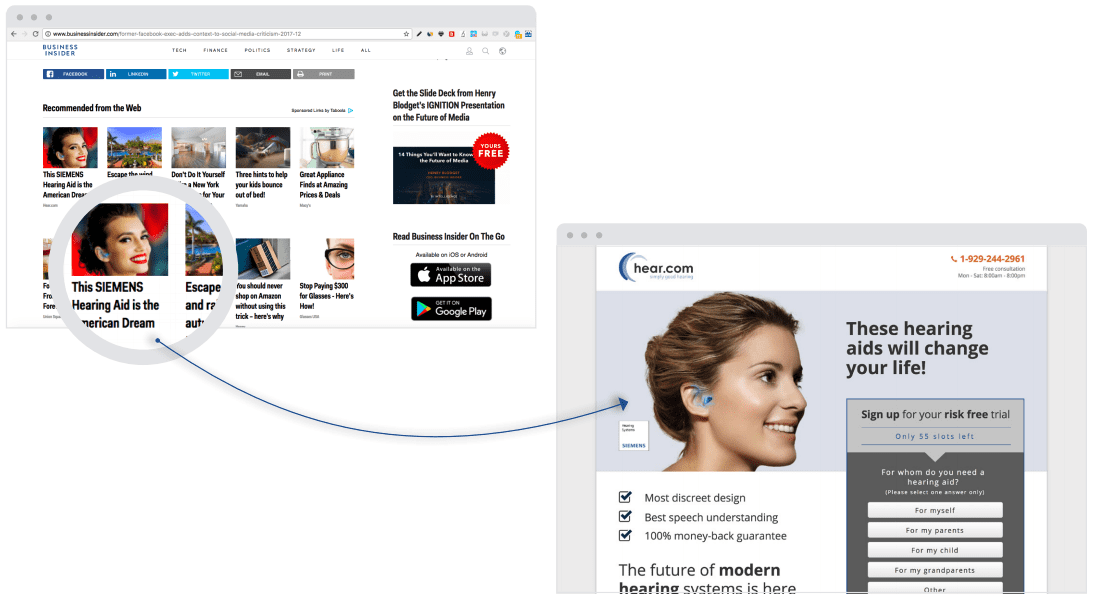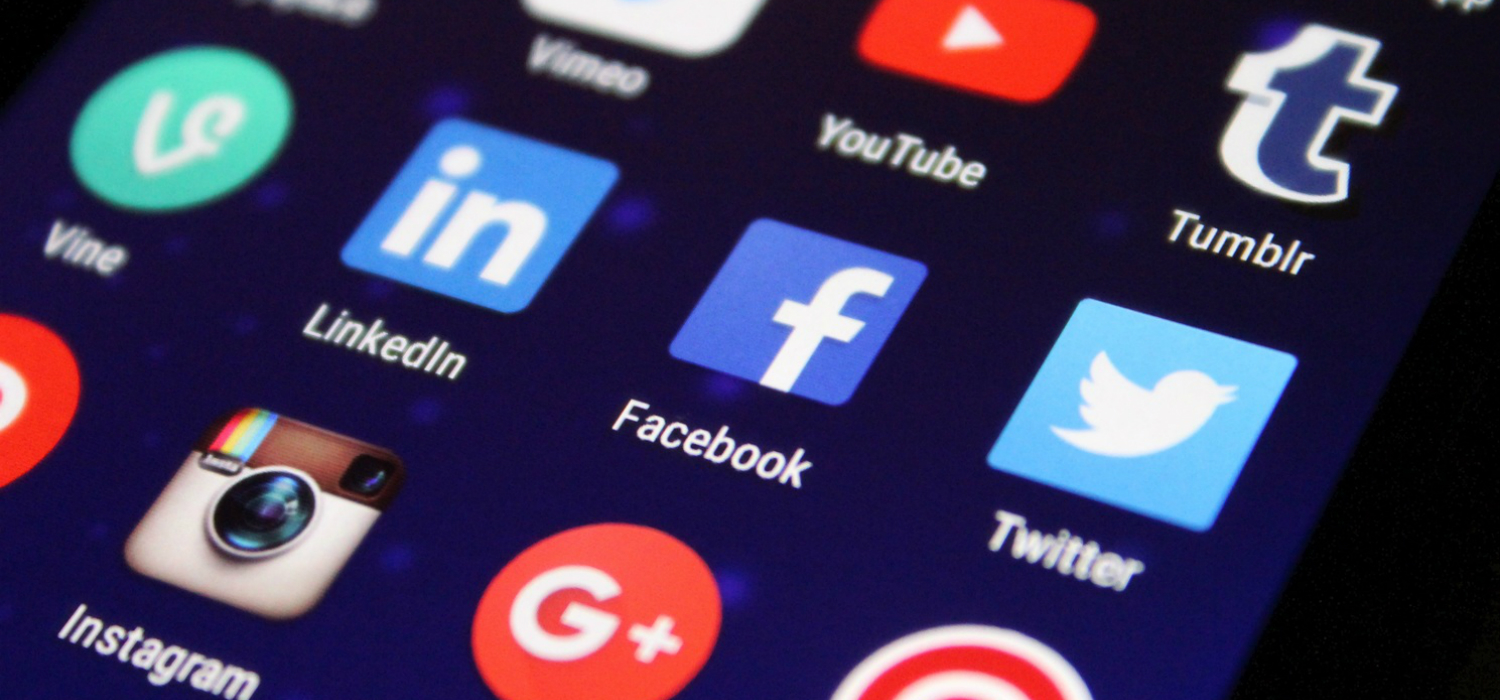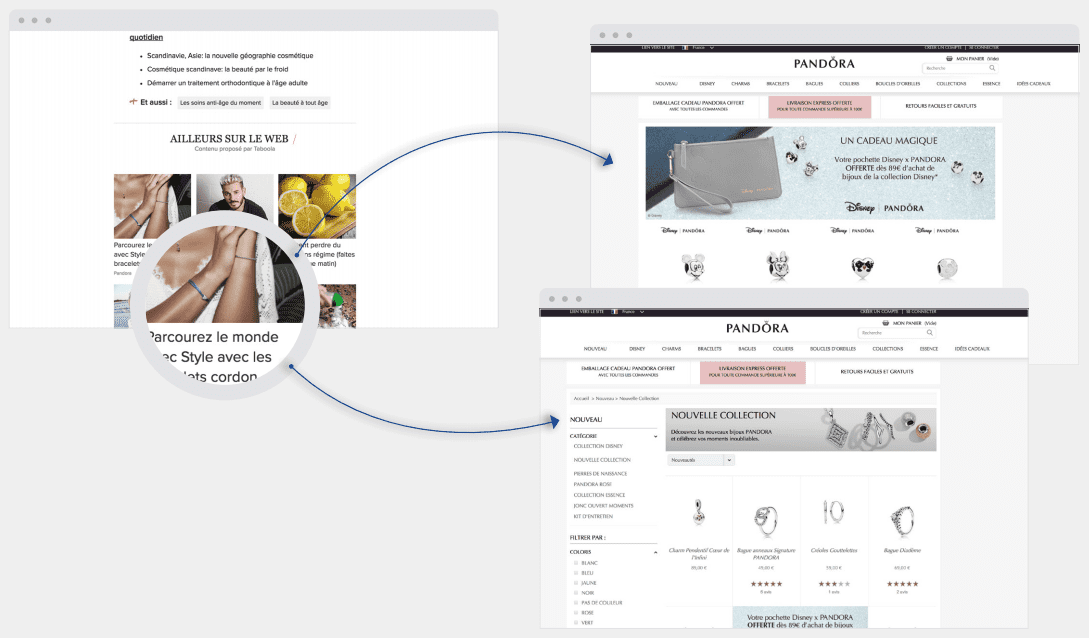What is performance marketing?
Performance marketing is a comprehensive term for online marketing and advertising programs where advertisers pay only when a specific action occurs. These actions can include a generated lead, a sale, a click, and more.
See also: Guides to Content Marketing Strategy, Brand Awareness and Lead Generation
Performance marketing professionals—in agencies, with media companies, publishers, or otherwise—rely heavily on paid marketing channels including:
- Native advertising
- Sponsored advertising
- Affiliate marketing
- Social media advertising
- Search engine marketing
In this post, we’ll unravel the essentials of performance marketing:
- How performance marketing works
- Terms you need to know
- An overview of the top platforms and channels available
Ready to Promote Your Content? Click Here to Get Started
How do performance marketing platforms work?
Let’s briefly explore how most platforms operate.
As is the case with all media (often purchased by media buyers), each channel has a specific audience and offers different types of advertising platforms to reach them. For instance:
- Facebook, the leading social media channel, offers a variety of options to show your ads to people visiting the Facebook or Instagram platform.
- Taboola, the leading content discovery network, offers advertisers the ability to reach the readers of tens of thousands of leading online publications.
- Google displays your ads in search results pages (and across the Google Ads network).
Obviously, no channel shows all the ads available, all the time, to everyone. So how do the different platforms choose what to show? A combination of the following factors come into play based on:
- Target audience and segmentation—Each ad platform offers ways for you to target your audience in the form of audience segments.
- Bid—The modern advertising landscape calls upon programmatic capabilities that factor in the amount you’ve agree to pay to show your ad in a specific place and time, to your chosen target audience.
- Quality and relevance—Trust is the biggest issue people have with advertising of any kind. As such, ad performance is factored. If your ad doesn’t work—that is, it earns low quality ratings—the network will reduce its exposure.
- Conversion—The economics of performance marketing is based on consumers taking action. When the required action doesn’t take place the network doesn’t get paid. So your ad gets displayed more when it works.
Facebook advertising (and the associated fees), for example, focuses heavily on the advertiser’s bid, ad quality and relevance , and estimated amount of actions. Most platforms work in a somewhat similar manner.
Performance Marketing Strategy

If performance marketing is about paying for action, it pays to have a strong grasp on the various strategies most commonly used, and the actions most commonly measured.
- Cost Per Impression (CPM): The amount an advertiser pays a publisher per one thousand times that their advertisement is shown
- Cost Per Click (CPC): The amount an advertiser pays only when their advertisement is clicked on
- Cost Per Sales (CPS): The amount an advertiser pays only when a sale is directly generated by an advertisement
- Cost Per Leads (CPL): The amount an advertiser pays when they receive a sign-up from an interested consumer as a direct result of their advertisement
- Cost Per Acquisition (CPA): The amount an advertiser pays when a specific action, such as a sale, a form completion, or a click, occurs
It’s worth noting that each of the above actions is an advertising objective and therefore a measure of performance marketing effectiveness. To evaluate your choices, and continue refining them, you’ll need to consider your campaign goals, choice of platforms, costs, and of course, results.
Top performance marketing channels
If performance marketing demands accountability, it follows that performance marketing channels are those that empower you to measure specific actions.
You already know how it works, and the basic terms, let’s look at the leading contenders now.
1. Native advertising

It’s a tough pill to swallow, but swallow it you must: most people in your target market are oblivious to digital advertising. They either have filters in place—such as ad blockers—or they filter ads subconsciously, or both.
Native advertising opens the door to creating click-through opportunities on the websites where your target market consumes content. Native advertising gets 10x more clicks than other forms of online advertising.
The linchpins of native advertising are:
- Offering quality content that provides value.
- Leveraging smart distribution via the right publishers.
The good news regarding the second requirement is content discovery platforms such as Taboola offer advanced predictive engines that ingest remarkable volumes of data to match viewers with content they’re likely to take interest in.
The nuances of launching successful content discovery campaigns via native advertising are nicely presented in this article and summarized in the following five steps:
- Set a goal—Determine a specific goal and define essential metrics to gauge progress.
- Right-fit the content—Aim to build campaigns around content with the potential to inspire action.
- Prepare your launch—Launch preparation involves selecting content, audience filters and budget parameters.
- Optimize—Fine-tune campaign performance by analyzing the data, identifying the publishers driving the best results, and adjusting your budget accordingly.
- Re-align and revise—Review how campaign performance compares to your original goal and look for ways to make it even more efficient with granular variables like time of day, site, and device type. Consider how content discovery might support additional efforts throughout the marketing funnel.
2. Sponsored content

Much like content discovery, sponsored articles are another form of native advertising considered to be content performance marketing plays. Sponsored articles can drive qualified traffic and conversions and increase overall online visibility in front of a highly targeted audience.
Native advertising expert Chad Pollitt writes:
“Sponsored articles have opened the door for brands to become part of natural conversations with consumers within the realm of their trusted environments—the publications they go to for news, education, and entertainment on a regular basis.”
Executed properly, sponsored articles have proven to be a financial win for both advertisers and publishers. In the Media Buyer’s Guide to Sponsored Editorial Content, Pollitt explains:
- Sponsored content means the publisher is a media outlet.
- The long-form editorial nature of sponsored articles distinguishes them from their short-form sponsored social counterparts.
- Association with a publication and exposure to its audience increases brand awareness, web traffic, conversions, and the likelihood of profitable consumer buying behavior.
A great example will be a Hear.com campaign.
Hear.com reached out to Taboola to partner on a performance marketing campaign utilizing sponsored content to create awareness around hearing loss and possible solutions.

Through educational-focused sponsored content, Hear.com was able to target specific geographical regions and increase traffic tenfold over two years.
38 Case Studies From Brands That Have Succeeded With Taboola
3. Social media advertising

It’s no secret that it has become far more difficult to achieve measurable results with organic reach via social media networks.
Consequently, agencies and media buying professionals are investing in social media advertising to play a role in their performance marketing programs.
Social networks provide you clear metrics to measure KPIs such as clickthrough rate (CTR), cost per click (CPC), and your overall ROI. As is the case with all performance marketing efforts, your starting point is to establish your objectives.
Reasonable objectives for social advertising include increasing:
- Traffic
- Engagement
- Lead generation
- Sales
The practical next step is to select the social platforms you’ll begin with. Consider the following:
- How the demographics of the network aligns with the brand.
- The traction you’ve gained on each network with your organic efforts.
- How your competition approaches the various social channels.
- Ad formats that can be used on the network.
Of course, the list of social media channels you can advertise on is long and includes Facebook, Instagram, Twitter, LinkedIn, YouTube, Snapchat, and Pinterest.
We won’t get into specific performance marketing campaign structures for each individually, however, consider the following best practices:
- Create specific target audiences by diving into the targeting options provided. You’ll twist the dials going forward as you hone in on your audience.
- Strive to create ads that blend well with the organic content found on each network. Blatantly promotional efforts tend to backfire on social.
- Take time to understand the pros and cons of the various formats offered.
- Experiment with your bidding strategy and optimize them over time to increase ROI.
- Refresh your ads and landing pages often.
4. Search engine marketing

Technically, the practice of search engine marketing (SEM) includes efforts to increase visibility and clicks via organic and paid advertising. In this post, we’ll address only paid, which is another viable performance marketing channel.
Thanks to the Google AdWords program, SEM has been the most popular performance marketing channel for decades. In 2017, Google’s ad revenue amounted to more than 95 billion US dollars.
Advocates of SEM will tell you its strength is it enables advertisers to put their ads in front of customers who are ready to buy.
Keywords are the foundation of SEM and choosing them wisely is a bit of a science. You’ll benefit from conducting comprehensive keyword research as part of your strategy aiming to identify keywords that are relevant to your brand, which prospective customers are likely to use when searching.
For obvious reasons, keywords with high commercial intent that include terms such as buy, discount, deal, coupon, and free shipping, are more competitive and thus, pricier.
On that note, it’s important to understand SEM is based on a real-time auction system. That is, an auction process takes place every time someone enters a search query. To be entered into the auction, advertisers identify keywords they’ll bid on and determine how much they are willing to spend for a click.
The process is a complex one, but understanding it is critical to achieving high ROI. WordStream is a leading vendor in the SEM software space and offers deep resources for mastering the bidding process at its PPC University site.
5. Affiliate marketing

Affiliate marketing is an established form of performance marketing. In this popular model, a publisher becomes an affiliate by establishing a relationship with an advertiser to produce traffic and sales (or an agree action).
Affiliates send traffic to advertisers and receive a commission in exchange for an agreed upon action (a sale, in most cases). Affiliate publishers essentially act as an extension of your brand using their site to sell your goods and services to users.
Any website operator can be an affiliate. Any brand operating online can be an advertiser though in most instances, the advertiser has an ecommerce brand or sells a solution via the web.
According to a recent report on the state of affiliate marketing from Business Insider:
- Affiliate marketing is growing and accounts for approximately 15% of the digital media industry’s revenue.
- Affiliate marketing now drives as many e-commerce orders in the U.S. as email.
- Publishers often take a native approach to affiliate marketing by embedding product links within organic content.
To be successful in performance marketing it’d be convenient to join an affiliate network that meets all expectations when it comes to a big base of users and cooperation perspectives. We’d recommend MyLead because of its multilingual and technical support, well-developed education system, advanced tools and interesting bonuses and promotional codes, thanks to which your brand will be promoted even more willingly.
Affiliate Marketing Software Platforms
Affiliate marketing software platforms act as a middleman for advertisers and marketers. Affiliates and an online merchant agree upon a specific action(s) that will result in a payout for the affiliate, and the platform ensures that these transactions are safe, fair, and not left to manual labor.
11 Best Affiliate Marketing Software Platforms
- Everflow: A cost effective platform with wide-ranging capabilities and a foolproof UI
- Post Affiliate Pro: A platform with large scalability, and a simple way for both merchants and affiliates to track success in real-time
- LinkTrust: A leader in attribution accuracy with a customizable UI
- CAKE: A cloud-based platform with robust and real-time management tools
- AffTrack: A mobile-friendly platform with unlimited clicks, easy-to-understand analytics, and 24/7 customer support
- Trackier: A platform with customizable reports, quick fraud detection, and a wide variety of integration capabilities
- Voluum: An end-to-end, easy to operate system with advanced tools to track and optimize campaigns
- Hitpath: A platform with reliable data and one of the simplest-to-use interfaces
- TUNE: An intuitive platform with robust features to operate and maintain successful affiliate marketing programs
- Click Inc: A platform with an approachable interface and a hands-on approach to maximizing affiliate campaigns
- Affise: A performance marketing platform to manage, track, analyze and optimize online advertising campaigns in real-time
Performance Marketing Example
For example, French jewelry manufacturer and designer PANDORA worked with Taboola on a recent native advertising campaign to boost branding and conversions via content discovery and display advertising methods.

These efforts led to shoppers spending more time on the PANDORA website, and over time, increasing the conversion rate up to 130%.
Content Performance Marketing
Content performance marketing is the intersection of content marketing and performance marketing, where advertisers create, publish, and distribute content they feel is most relevant to their desired audience while simultaneously working to meet demand, optimize, and measure the success of the content. The three steps involved in content performance marketing are:
-
- Target Demand: In this step, advertisers determine where their audience is most likely to be looking for their product or service. It’s also gauging an understanding of the types of content a particular audience likes to consume and creating bespoke content that fits those parameters.
- Optimize Content: Once content is created to meet a demand, data must be analyzed in real-time to determine how content can become more successful. An example of this is keeping a close eye on SEO.
- Measure Results: To inform future pieces of content, it’s crucial for advertisers to use learnings from past content performance campaigns. Setting strong KPIs allows advertisers to spend wisely and eliminate guesswork.
A Quick Recap about the Types of Performance Marketing
Here’s a concise checklist indicating when to pursue specific performance marketing channels.
- Native advertising—Content discovery programs enable you to dramatically scale the reach of your content and achieve click-through to specific landing via the websites of publishers. This form of native advertising can be particularly fruitful for brands that are not achieving their goals via search and social media channels.
- Sponsored content—Another form of native advertising, sponsored content does not immediately drive traffic offsite, but instead to a page on the publisher’s site. Sponsored content is a worthy investment for augmenting a brand’s owned media and can help reach those who tune-out traditional ads.
- Social media advertising—Although social media advertising can run-up a sizable tab, ad programs offered by Facebook, Instagram, Twitter, LinkedIn and other channels enable marketers to target prospects with great precision and overcome the challenge of gaining exposure via organic posts.
- Search engine marketing—Pay-per-click programs offered by Google and Bing accelerate a brand’s exposure via search engine results pages for keywords in ways organic SEO cannot. SEM ad programs are reputed to deliver high commercial intent and therefore impressive ROI for brands that have finely tuned their programs.
- Affiliate marketing—Many brands pursue affiliate marketing and realize a strong return on investment (ROI). It’s essentially free advertising.
Performance marketing is a great strategy when you want to be able to measure results, and get them fast.
To really hit your business goals, it’s important you build your campaigns strategically—choose the right platform, ad format, optimization goals, focus on the right audience and of course—create an ad that will resonate with your target audience.
[marketoform id=9011]